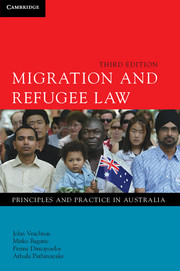Book contents
- Frontmatter
- Contents
- Table of cases
- Table of statutes
- Preface to the third edition
- Acknowledgments
- 1 Historical context to migration
- 2 Immigration control: An overview
- 3 Basic migration legislation and policy
- 4 The visa system and application procedures
- 5 Family and interdependency migration and other Australia-based visas
- 6 Business and investment visas
- 7 Skills-based visas
- 8 Temporary visas
- 9 Miscellaneous visas
- 10 Common visa requirements
- 11 Compliance: Unlawful non-citizens, removal and deportation
- 12 History of the Refugees Convention and definitional framework
- 13 Refugee and humanitarian visas: The statutory structure
- 14 Convention grounds
- 15 Persecution
- 16 Well-founded fear of persecution
- 17 Limits on protection of refugees – cessation, exclusion exceptions and protection by another country
- 18 Time for a fundamental rethink: Need as the criterion for assistance
- 19 The determination and review process for migration and refugee decisions
- Index
13 - Refugee and humanitarian visas: The statutory structure
Published online by Cambridge University Press: 05 June 2012
- Frontmatter
- Contents
- Table of cases
- Table of statutes
- Preface to the third edition
- Acknowledgments
- 1 Historical context to migration
- 2 Immigration control: An overview
- 3 Basic migration legislation and policy
- 4 The visa system and application procedures
- 5 Family and interdependency migration and other Australia-based visas
- 6 Business and investment visas
- 7 Skills-based visas
- 8 Temporary visas
- 9 Miscellaneous visas
- 10 Common visa requirements
- 11 Compliance: Unlawful non-citizens, removal and deportation
- 12 History of the Refugees Convention and definitional framework
- 13 Refugee and humanitarian visas: The statutory structure
- 14 Convention grounds
- 15 Persecution
- 16 Well-founded fear of persecution
- 17 Limits on protection of refugees – cessation, exclusion exceptions and protection by another country
- 18 Time for a fundamental rethink: Need as the criterion for assistance
- 19 The determination and review process for migration and refugee decisions
- Index
Summary
Overview
Australia became a signatory to the 1951 United Nations Convention Relating to the Status of Refugees (the Convention) in 1954 and to the 1967 Protocol in 1973. It thereby assumed certain obligations under the Convention, the principal one being to grant asylum to people who fall within the definition of a refugee as set out in Article 1A(2). The process or manner in which asylum is granted is not expressly stipulated in the Convention. It is governed by the Migration Act 1958 (Cth).
The Migration Act 1958 (Cth) provides for visas to be issued on refugee and humanitarian grounds to applicants under the government's humanitarian program. That program is made up of onshore protection for those people already in Australia, whether or not they arrived with temporary visas or without a visa at all, and resettlement in Australia for people in humanitarian need overseas (including those who are classified as refugees by the UN High Commissioner for Refugees (UNHCR) and recommended for resettlement). Previously, both the onshore and offshore visa categories included both permanent and temporary residence visas. Now temporary visas have been abolished.
- Type
- Chapter
- Information
- Migration and Refugee LawPrinciples and Practice in Australia, pp. 182 - 190Publisher: Cambridge University PressPrint publication year: 2011

